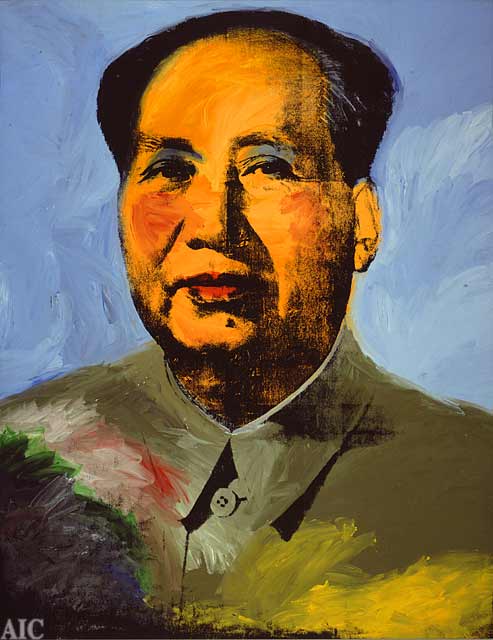Andy Warhol Gallery
Acrylic and silkscreen on canvas
448.3 x 346.7 cm
Mao is one of a series of silkscreened portraits of the Chinese Communist leader Mao Zedong (1893-1976) that Warhol produced in 1973. Nearly 15 feet tall, this towering image mirrors representations that were displayed throughout China during and after the Cultural Revolution (1966-76). Warhol was undoubtedly drawn to this subject because of the media’s attention to the opening of diplomatic relations with the People's Republic of China in the early 1970s. His irreverent attitude toward China’s totalitarian propaganda is apparent on the surface of the painting. Flamboyant brushstrokes compete with the photographic image, forming color splashes on Mao’s clothing. Red rouge and blue eye shadow resemble graffiti. These details can be interpreted as commentary on the resemblance of Communist propaganda to capitalist advertising media.

viewer |
|
|
Mao |
| Jenkins |
| Self-Portrait |
| Bills |
| Empire |
| Marilyn |
| Elvis |
| Basquiat |
Biography
Bulletin Board
Renowned Art
(home)
Warhol was born in Pittsburgh. He is a founder and major figure of the POP ART movement. Warhol pioneered the development of the process whereby an enlarged photographic image is transferred to a silk screen that is then placed on a canvas and inked from the back. It was this technique that enabled him to produce the series of mass-media images - repetitive, yet with slight variations. These, incorporating such items as Campbell's Soup cans, dollar bills, Coca-Cola bottles, and the faces of celebrities, comment on the banality, harshness, and ambiguity of American culture. Andy traveled around the country with The Velvet Underground (Lou Reed and John Cale). In 1968, Valerie Solanis, a rejected superstar, came into The Factory and shot Andy three times, he was pronounced dead, but after having his chest cut open, he survived.
all artists, with thumbnails: by birth year | alphabetically
all artists: by birth year | alphabetically
artists born in the 13th 14th 15th 16th 17th 18th 19th 20th century